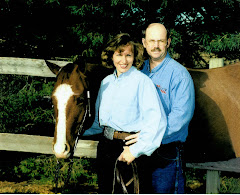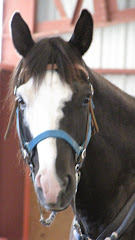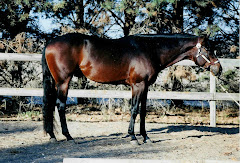On my
chat group, Horses Are Our Lives, last week we discussed Training Tips on Ground Manners. Below is some of the discussion.
Let's talk about ground manners. We should have lots of ideas to what we do with the horses. There are many, so just pick one to talk about each day. Today - how about the beginning. I would like to start with bonding with the horse. I love to free lunge to get the horse to bond with me. This not only teaches the horse to bond, but also shows the horse that I am the leader. Horses want to have a leader. They want a horse to alert them to danger, to take them to water, to let them know what it is ok to rest. I want the horse to look at me to be his/her leader and to trust me. With free lunging, ground manners start as it teaches the horse respect. To have good ground manners, you need the horse's respect.
What do you do to bond with your horse?
Discussion followed, with my answers:
Yes, I think we all should do things a little different with each horse, as they are individuals also.
Terri, as I respond to your email, I am just going to answer as if I'm talking to the group, not to you specifically. I'm just going to talk about some of your thoughts! Thanks for your insight!
Some horses can take more pressure, some can't. And pressure comes in many forms. As you work with your horse, watch that you don't give your horse too much pressure. Watch for when your horse becomes uncomfortable as you are doing anything, and if you see that discomfort, back down to something easier.
I like that - loving energy in my hands. I also rub a horse at certain times during training. I can't say at a specific time, just at a specific "feel". I sense when the horse relaxes/is comfortable/wants a buddy, and that is when I rub between the eyes.
I'm sorry you were off today. Something was different today for you. Yes, it is important to center yourself, and that is one lesson that I have really learned this last year. I have found a calmness, but it hasn't stayed with me every day. Remember, as women, we do have hormones to deal with, and when I'm feeling off, I take a step back to find out what is going on inside my body. Maybe we need to do the same things with the horses, when they are a little off??? Something to think about.
Definitely listen to your gut. Even when conditions aren't perfect, we can ride, but stay safe. Sometimes, I forget that I can get ahead with slow work just as I can condition a horse with fast work.
You had a bonding ride with that filly. That was neat. Building trust is important. I'm sure the next ride is going to be even better. Once your own the road where everything is going right, it just keeps spiraling upwards. That's because we know when not to pressure the horse, but keep it easy for the horse to succeed!
Next topic - leading! I don't like a horse that steps almost on top of me when something spooks it! I want the horse to lead with his head a little in front of me, so that we are eye to eye. I want him over a foot or so. I think this is one of the hardest things to teach.
I have seen trainers who want that horse behind them and they want the horse to stop when the trainer stops. I can teach that, as each time you stop, you turn and make the horse back up. But most of the time I see this in practice, the horse is being intimidated and frightened that if they don't do what is being asked, then will be swatted with the lead rope. And I want to see the horse that I'm leading and not give it a chance to jump over me if something scares it from behind.
A lot of time when you first start leading a horse, the horse is leaning towards you. I do a lot of turns away from me, to the right, so that I am walking around the horse as I'm reversing the horse. This teaches the horse to move the shoulder away from me.
I also start to lead with my arm out to the side, keeping the horse a foot away from me. As the horse leads at that distance, my arm becomes more relaxed and I have some slack in the lead rope.
Then practice walking with that horse! Keeping the horse from jumping on top of the person leading it is a huge ground manners lesson.
Some additional thoughts after some discussion on the chat group: the eye and shoulder are in the same line so the horses head is at or a little forward of this line. For the height of the head, I like my horses to lead with their head also at the shoulder area - not too high or too low. I guess I never thought of exactly where - just an area.
Everyone should consider their bubble and where they want the horse to be and
not be. In Centered Riding, we ride in a bubble also.
Right now, I'm teaching some young horses to lead. What a chore! I just give
and take with the lead rope, to get them to follow the forward pressure on the
lead rope. Sometimes, I can tap behind me with the end of the lead rope to touch
the horse on the side, and that is incentive to get the horse to move forward.
Shaggy does not like that at all. With him, I think it is just going to take
time to get him to move out and walk beside me without hesitating.
How many of us have our horse's face in our face, or their mouth on our arm, or pushing us with their head? Is your horse mouthy?
I don't want my horse to do any of these. We showed showmanship and that horse needs to stand quiet all the time. We start in the stall, tie up the horse (always high, at least at eye level, but I am always tying higher than that). As we groom, and the horse reaches around to touch us with his/her mouth, we gently push the head back to face front. As the horse keeps reaching around, then the elbow is ready to lift and hit the horse, gently at first, under the jaw. The elbow hit becomes stronger until the horse learns to not turn his head. Remember to work equal lengths of time on each side of the horse. You may want to start grooming on the side of the horse that seems harder for the horse to stand still, go to the other side, and return to the first side.
I don't feed treats from my hand, and I don't have trouble with horses being mouthy and looking for treats.
If I'm leading a horse, and he/she turns towards me, I'll use my elbow to bump the horse's jaw or side of head to keep it away from me.
Don't bump too hard with the elbow - you don't want a sore elbow! That horse's head is hard!
What do you do to teach your horse to not be mouthy?
I’ve enjoyed the discussion this week.
Come join us at:
http://sports.groups.yahoo.com/group/horsesareourlives/Brenda
“Embrace the Journey!”







